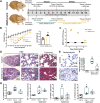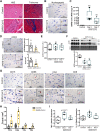SARS-CoV-2 infection downregulates myocardial ACE2 and potentiates cardiac inflammation in humans and hamsters
- PMID: 36367689
- PMCID: PMC9705018
- DOI: 10.1152/ajpheart.00578.2022
SARS-CoV-2 infection downregulates myocardial ACE2 and potentiates cardiac inflammation in humans and hamsters
Abstract
Myocardial pathologies resulting from SARS-CoV-2 infections are consistently rising with mounting case rates and reinfections; however, the precise global burden is largely unknown and will have an unprecedented impact. Understanding the mechanisms of COVID-19-mediated cardiac injury is essential toward the development of cardioprotective agents that are urgently needed. Assessing novel therapeutic strategies to tackle COVID-19 necessitates an animal model that recapitulates human disease. Here, we sought to compare SARS-CoV-2-infected animals with patients with COVID-19 to identify common mechanisms of cardiac injury. Two-month-old hamsters were infected with either the ancestral (D614) or Delta variant (B.1.617.2) of SARS-CoV-2 for 2 days, 7 days, and/or 14 days. We measured viral RNA and cytokine expression at the earlier time points to capture the initial stages of infection in the lung and heart. We assessed myocardial angiotensin-converting enzyme 2 (ACE2), the entry receptor for the SARS-CoV-2 virus, and cardioprotective enzyme, as well as markers for inflammatory cell infiltration in the hamster hearts at days 7 and 14. In parallel, human hearts were stained for ACE2, viral nucleocapsid, and inflammatory cells. Indeed, we identify myocardial ACE2 downregulation and myeloid cell burden as common events in both hamsters and humans infected with SARS-CoV-2, and we propose targeting downstream ACE2 downregulation as a therapeutic avenue that warrants clinical investigation.NEW & NOTEWORTHY Cardiac manifestations of COVID-19 in humans are mirrored in the SARS-CoV-2 hamster model, recapitulating myocardial damage, ACE2 downregulation, and a consistent pattern of immune cell infiltration independent of viral dose and variant. Therefore, the hamster model is a valid approach to study therapeutic strategies for COVID-19-related heart disease.
Keywords: ACE2; COVID-19; heart; inflammation.
Conflict of interest statement
Z. Kassiri is an editor of
Figures



Similar articles
-
Hamsters Expressing Human Angiotensin-Converting Enzyme 2 Develop Severe Disease following Exposure to SARS-CoV-2.mBio. 2022 Feb 22;13(1):e0290621. doi: 10.1128/mbio.02906-21. Epub 2022 Jan 25. mBio. 2022. PMID: 35073750 Free PMC article.
-
SARS-coronavirus modulation of myocardial ACE2 expression and inflammation in patients with SARS.Eur J Clin Invest. 2009 Jul;39(7):618-25. doi: 10.1111/j.1365-2362.2009.02153.x. Epub 2009 May 6. Eur J Clin Invest. 2009. PMID: 19453650 Free PMC article.
-
Recombinant ACE2 Expression Is Required for SARS-CoV-2 To Infect Primary Human Endothelial Cells and Induce Inflammatory and Procoagulative Responses.mBio. 2020 Dec 11;11(6):e03185-20. doi: 10.1128/mBio.03185-20. mBio. 2020. PMID: 33310781 Free PMC article.
-
Role of angiotensin-converting enzyme 2 and pericytes in cardiac complications of COVID-19 infection.Am J Physiol Heart Circ Physiol. 2020 Nov 1;319(5):H1059-H1068. doi: 10.1152/ajpheart.00681.2020. Epub 2020 Oct 9. Am J Physiol Heart Circ Physiol. 2020. PMID: 33036546 Free PMC article. Review.
-
The pivotal link between ACE2 deficiency and SARS-CoV-2 infection.Eur J Intern Med. 2020 Jun;76:14-20. doi: 10.1016/j.ejim.2020.04.037. Epub 2020 Apr 20. Eur J Intern Med. 2020. PMID: 32336612 Free PMC article. Review.
Cited by
-
The possible mechanism and research progress of ACE2 involved in cardiovascular injury caused by COVID-19: a review.Front Cardiovasc Med. 2024 May 27;11:1409723. doi: 10.3389/fcvm.2024.1409723. eCollection 2024. Front Cardiovasc Med. 2024. PMID: 38863899 Free PMC article. Review.
-
Activation of limbal epithelial proliferation is partly controlled by the ACE2-LCN2 pathway.iScience. 2024 Jul 18;27(8):110534. doi: 10.1016/j.isci.2024.110534. eCollection 2024 Aug 16. iScience. 2024. PMID: 39175771 Free PMC article.
-
Sex differences in the cardiac stress response following SARS-CoV-2 infection of ferrets.Am J Physiol Heart Circ Physiol. 2023 Nov 1;325(5):H1153-H1167. doi: 10.1152/ajpheart.00101.2023. Epub 2023 Sep 22. Am J Physiol Heart Circ Physiol. 2023. PMID: 37737732 Free PMC article.
-
Factors Influencing COVID-19 Viral Clearance: Implications for Vaccination and Antiviral Therapy.Infect Drug Resist. 2025 Aug 21;18:4227-4240. doi: 10.2147/IDR.S515224. eCollection 2025. Infect Drug Resist. 2025. PMID: 40861788 Free PMC article.
-
COVID-19, Myocarditis and Pericarditis.Circ Res. 2023 May 12;132(10):1302-1319. doi: 10.1161/CIRCRESAHA.123.321878. Epub 2023 May 11. Circ Res. 2023. PMID: 37167363 Free PMC article. Review.
References
-
- Wang K, Gheblawi M, Nikhanj A, Munan M, MacIntyre E, O'Neil C, Poglitsch M, Colombo D, Del Nonno F, Kassiri Z, Sligl W, Oudit GY. Dysregulation of ACE (angiotensin-converting enzyme)-2 and renin-angiotensin peptides in SARS-CoV-2 mediated mortality and end-organ injuries. Hypertension 79: 365–378, 2022. doi:10.1161/HYPERTENSIONAHA.121.18295. - DOI - PubMed
-
- Chan JF-W, Zhang AJ, Yuan S, Poon VK-M, Chan CC-S, Lee AC-Y, Chan W-M, Fan Z, Tsoi H-W, Wen L, Liang R, Cao J, Chen Y, Tang K, Luo C, Cai J-P, Kok K-H, Chu H, Chan K-H, Sridhar S, Chen Z, Chen H, To KK-W, Yuen K-Y. Simulation of the clinical and pathological manifestations of Coronavirus Disease 2019 (COVID-19) in a golden Syrian hamster model: implications for disease pathogenesis and transmissibility. Clin Infect Dis 71: 2428–2446, 2020. doi:10.1093/cid/ciaa325. - DOI - PMC - PubMed
-
- Huang J, Hume AJ, Abo KM, Werder RB, Villacorta-Martin C, Alysandratos KD, Beermann ML, Simone-Roach C, Lindstrom-Vautrin J, Olejnik J, Suder EL, Bullitt E, Hinds A, Sharma A, Bosmann M, Wang R, Hawkins F, Burks EJ, Saeed M, Wilson AA, Mühlberger E, Kotton DN. SARS-CoV-2 infection of pluripotent stem cell-derived human lung alveolar type 2 cells elicits a rapid epithelial-intrinsic inflammatory response. Cell Stem Cell 27: 962–973.e7, 2020. doi:10.1016/j.stem.2020.09.013. - DOI - PMC - PubMed
Publication types
MeSH terms
Substances
Supplementary concepts
Grants and funding
LinkOut - more resources
Full Text Sources
Medical
Miscellaneous

